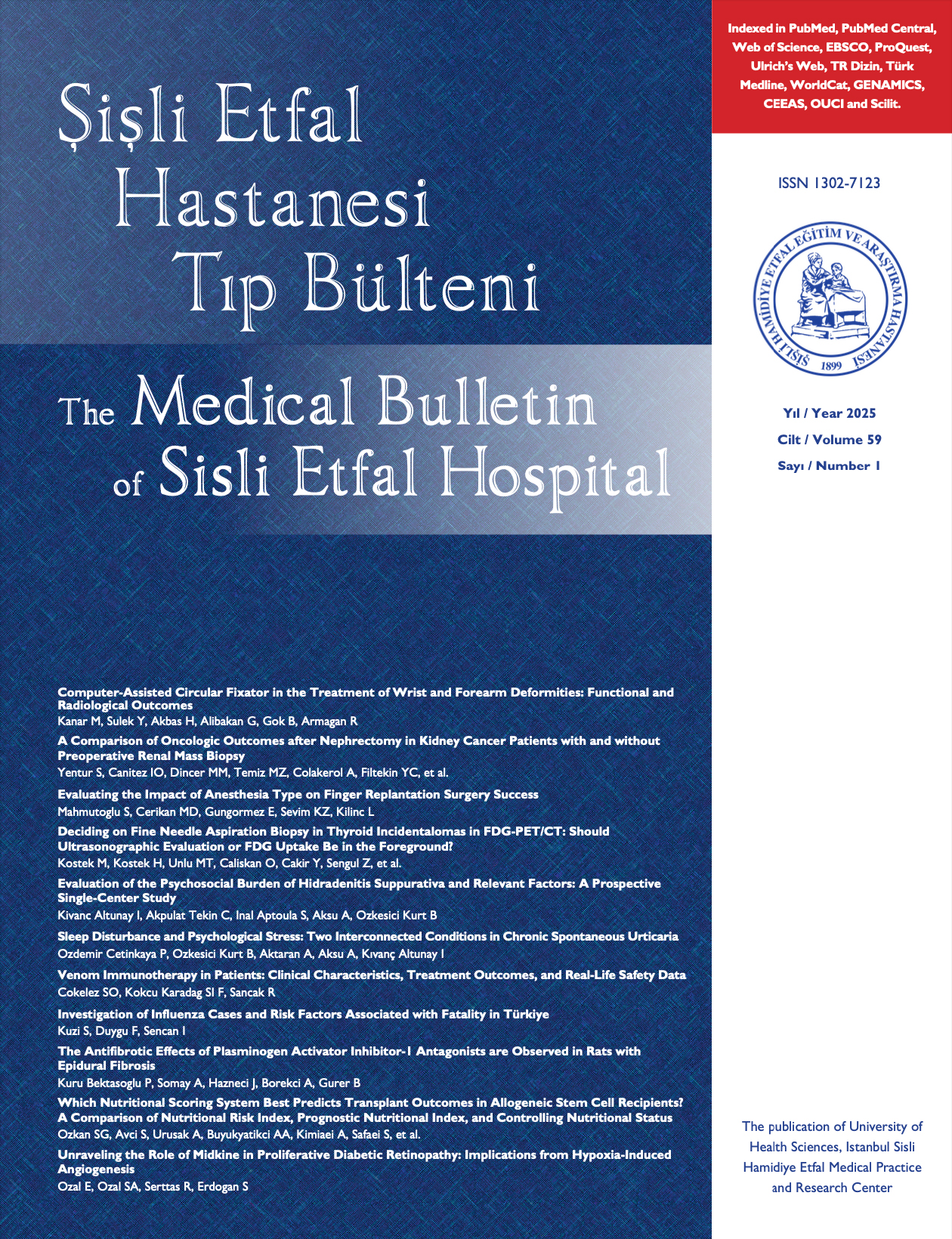
The effect of pentoxifylline on doxorubicin induced extravasation injury
Medeni Volkan Kıyak1, Ayşin Karasoy Yeşilada1, Mehmet Oğuz Yenidünya1, Fulya Öz Puyan21Department of Plastic and Reconstructive Surgery, Şisli Etfal Training and Research Hospital, Istanbul, Turkey2Department of Pathology, Trakya university, Faculty of Medicine, Edirne, Turkey
Objectives: Extravasation injury is characterized by leakage of pharmacologic or non-physiologic substances from the vessel into the tissue, causing destruction. Full-thickness skin necrosis after extravasation of the widely used chemotherapeutic agent doxorubicin, is a significant source of morbidity in cancer patients. This progressive tissue necrosis may lead to pain, ulceration and disfiguring tissue loss. Although, various treatment options have been proposed for this type of injury, there is no consensus regarding the management of such lesions. The aim of this study was to determine the effectiveness of pentoxifylline and the relationship between usage duration and efficiency of the drug as a treatment in a rat extravasation model.
Study Design: The study was done on forty Wistar-Albino rats, weighing 300 to 350 g, All rats received 1 mg of doxorubicin in 1 cc of saline intradermal flank injection to stimulate extravasation injury. The rats were divided into three groups and intraperitoneal pentoxifylline of 50 mg/kg/day was administered within 12-hour intervals. Group1: they got the treatment on the same day with the injury (n=10). Group 2: they got the treatment 1 day after the injury (n=10). Group 3: Control group (saline infusion was administered). At the end of seventh, tenth, twelfth and fifteenth days, the size of ulcers at the injection site were calculated via Planimetri ® software image analysis program. A biopsy specimen, including all necrotic tissue and surrounding healthy tissue, was obtained at the end of the fifteenth day.
Results: In groups 1and 2 there were statistically significant differences in the sizes of necrosis compared with control group (P<0,01). In group 1 and 2, these was not statistically significant difference. Area of necrosis in Group 1 was similar to that in Group 2.
Conclucion: The data suggest that pentoxifylline is effective in the treatment of doxorubicin induced extravasation injury when administered on the day of and after doxorubicin injection.
Doksorubisine bağlı ekstravazasyon hasarında pentoksifilinin etkisi
Medeni Volkan Kıyak1, Ayşin Karasoy Yeşilada1, Mehmet Oğuz Yenidünya1, Fulya Öz Puyan21Şisli Etfal Eğitim Ve Araştırma Hastanesi, Plastik Rekonstrüktif Ve Estetik Cerrahi Kliniği, İstanbul2Trakya Üniversitesi, Tıp Fakültesi Patoloji Anabilim Dalı, Edirne
Giriş ve Amaç: Ekstravazasyon yaralanması, damar dışına kaçan farmakolojik veya fizyolojik olmayan ajanların doku yıkımı yapması ile karakterize bir durumdur. Kemoterapötik olarak sıkça kullanılan doksorubisinin ekstravazasyonu sonucu gelişen tam kat cilt nekrozu kanser hastalarının önemli bir morbidite kaynağıdır. Bu ilerleyici doku nekrozu ağrı, ülserasyon, şekil ve fonksiyon bozukluğuna neden olan doku kaybına yol açabilir. Bu yaralanmalarda çeşitli tedavi seçenekleri önerilmesine rağmen, bu gibi lezyonların tedavisi hakkında fikir birliği sağlanmamıştır. Bu çalışmanın amacı sıçan ekstravazasyon modelinde pentoksifilinin etkisini ve kullanım zamanıyla etkinlik ilişkisini belirlemektir.
Gereç ve Yöntem: Ağırlıkları 300-350 gr olan 30 adet Wistar-Albino sıçanların tümüne 1 mg doksorubisin, 1cc izotonik içinde intradermal olarak enjekte edildi. Hayvanlar 3 gruba ayrılarak 50mg/kg/gün pentoksifilin intraperitoneal olarak günde iki kez (12 saat ara ile) uygulandı. Gruplar sırayla: Grup 1: hasar ile aynı gün tedaviye başlandı (n=10), Grup2: hasardan sonraki gün tedaviye başlandı (n=10), Grup 3: kontrol grubu (sadece serum fizyolojik verildi). Yaralanmadan 7, 10, 12 ve 15 gün sonra enjeksiyon yerinde ülser boyutu görüntü analiz programı yöntemi ile ölçüldü. Biyopsi materyali tüm nekrotik dokuları ve çevresindeki sağlıklı dokuyu içerecek şekilde elde edildi.
Bulgular: Grup 1 ve 2deki nekroz boyutları, grup 3 (kontrol grubu) ile karşılaştırıldığında istatistiksel olarak anlamlı fark saptandı (p<0,01). Grup 1 nekroz alanı grup 2 ile benzerdi, iki grup arasında istatistiksel olarak anlamlı fark saptanmadı (p>0,05).
Sonuç: Bu veriler sıçanlarda doksorubisin ile gerçekleştirilen ekstravazasyon hasarının azaltılmasında pentoksifilinin hasardan hemen sonra ya da 1 gün sonra kullanılması anlamlı fark olmadığından yaralanmanın süresi ne olursa olsun kullanılmasının yararlı olduğunu göstermektedir.
Manuscript Language: Turkish



















